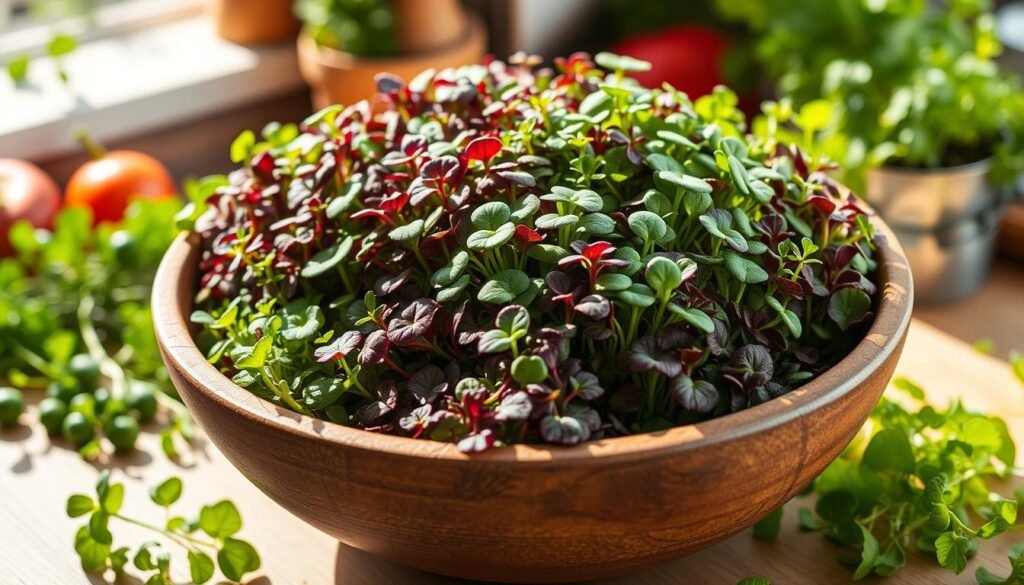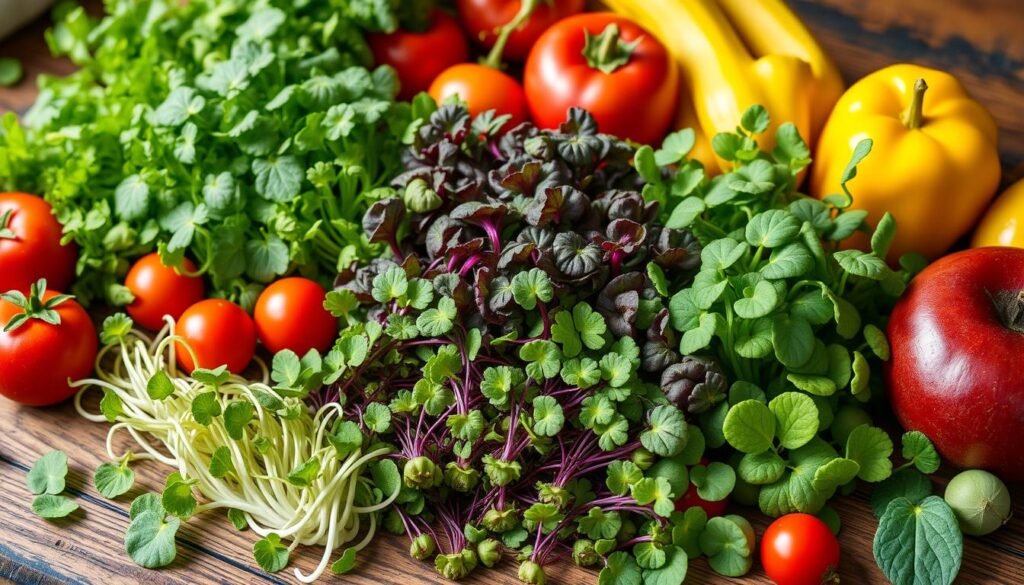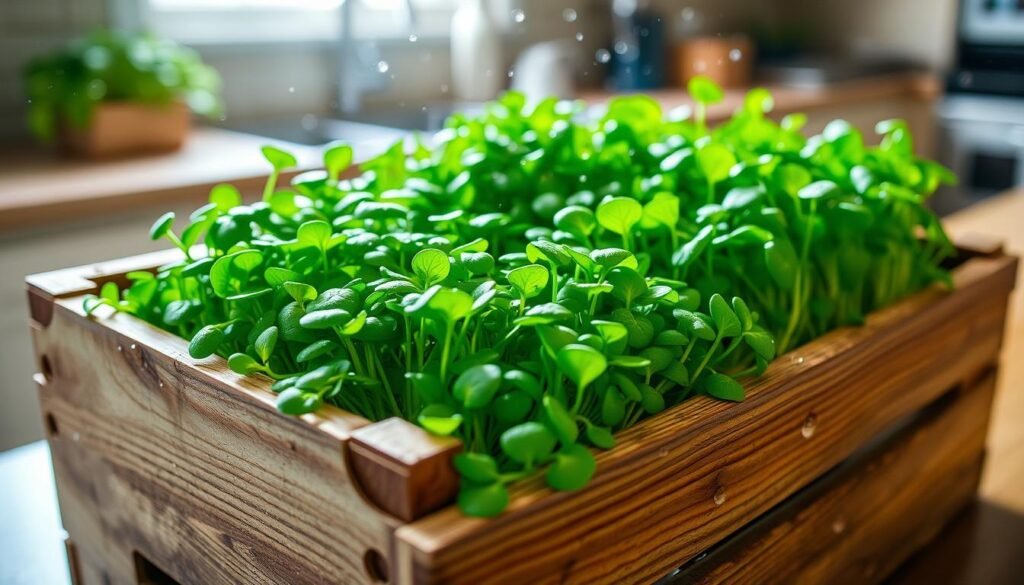Did you know microgreens have up to 40 times more vitamins and nutrients than mature plants? This fact shows why these small greens are becoming so popular. They are full of flavor and loaded with nutrients. Microgreens are great for anyone wanting to boost their diet and health. Adding microgreens to your meals means you’re looking after your health. Plus, their taste is simply delightful.
Key Takeaways
- Microgreens offer a nutrient density that surpasses mature plants.
- They are considered superfood microgreens due to their rich health benefits.
- Their incorporation can lead to improved overall nutrition.
- Microgreens health advantages include boosting immunity and aiding digestion.
- These greens can easily fit into various meals and snacks.
- Growing microgreens at home is an accessible way to enhance your diet.
What Are Microgreens?
Microgreens are young plants, usually picked when they’re about one to three inches tall. They come from various types of microgreens like veggies, herbs, and some grains. Favorites include arugula, cabbage, and cilantro. They add flavor and color to meals.
These small greens are packed with taste and textures. They’re easy to grow, both at home and commercially. Learning about what are microgreens lets anyone improve their dishes. They add taste and have many microgreens benefits for our health.
Growing microgreens at home is fulfilling. It lets you enjoy their freshness and health benefits. You can add them to salads, sandwiches, or smoothies. With some basic knowledge, you can enjoy these nutritious greens in your own home.
| Type of Microgreen | Flavor Profile | Nutritional Highlights |
|---|---|---|
| Arugula | Peppery | High in Vitamin K, Calcium |
| Cilantro | Fresh, citrusy | Rich in Antioxidants, Vitamins A and K |
| Radish | Spicy | Vitamin C, Folate |
Microgreens Benefits: The Nutritional Powerhouse
Microgreens are known for their incredible nutritional powerhouse status. They are loaded with essential vitamins and minerals. This makes them a great addition to any meal. Their nutrient levels are often much higher than their full-grown versions. This is one of the main microgreens benefits for those focused on health.
High in Nutrients
Studies show that microgreens like broccoli and kale are nutrient-rich. They have a variety of key vitamins and minerals. Here’s a quick look at some nutrients found in these greens:
| Microgreen Variety | Vitamins | Minerals |
|---|---|---|
| Broccoli | A, C, E, K | Calcium, Potassium |
| Kale | A, C, K | Iron, Magnesium |
| Radish | B, C | Potassium, Calcium |
Loaded with Antioxidants
Another top reason to eat microgreens is their antioxidant-rich microgreens benefit. These greens fight oxidative stress in the body. This can reduce the risk of chronic diseases. Eating foods high in antioxidants helps in staying healthy long-term. Adding microgreens to your diet can boost taste and health benefits.

Exploring Microgreens Nutrition
Discover the power of microgreens nutrition. These small greens are packed with vital vitamins and minerals. They boost your health in big ways.
The vitamins and minerals found in microgreens make them valuable in a healthy diet.
Vitamins and Minerals in Microgreens
Microgreens are full of important vitamins and minerals. They have lots of vitamin C, which helps keep you healthy. You’ll also find vitamin K for strong bones and B vitamins for energy.
They’re packed with minerals like calcium for bones, and magnesium and potassium for blood pressure. Adding microgreens to your meals offers great flavor and many health benefits.
Macro and Micronutrients Explained
Both types of nutrients, macro and micro, are key for good health. Macros give you energy and the building blocks your body needs. Microgreens are rich in both, supporting everything from cell repair to a stronger immune system.
Adding microgreens to your diet is a tasty way to get these necessary nutrients.
Health Advantages of Microgreens
Microgreens aren’t just tiny plants. They pack a big punch for health. They boost immunity and aid digestion, making them great for any diet.
Boosting Immunity
Microgreens are loaded with vitamins C and E. These vitamins help strengthen our immune system. They make our bodies better at fighting off illnesses. So, eating microgreens often can keep you healthier and more robust.
Supporting Digestive Health
Microgreens also support a healthy gut. They are full of dietary fiber, which is key for good digestion. This fiber helps keep digestive problems away, making for better nutrient absorption and wellness.

| Microgreens Type | Vitamin C Content (mg per 100g) | Dietary Fiber (g per 100g) |
|---|---|---|
| Basil | 60 | 2.6 |
| Sunflower | 46 | 0.8 |
| Pea Shoots | 49 | 1.8 |
Nutritious Microgreen Varieties to Try
Exploring nutritious microgreen varieties adds vibrant flavors and top nutrition to meals. Popular choices include basil, radish, and sunflower microgreens. Each offers unique benefits to your diet.
Basil Microgreens
Basil microgreens are known for their aromatic smell and high nutrient content. They’re rich in vitamin K, important for bone health and blood clotting. Adding them to your meals boosts flavor and nutrition.
Radish Microgreens
Radish microgreens offer a zesty flavor, great for salads and sandwiches. They’re loaded with vitamin C and antioxidants. These nutrients boost your immune system and fight oxidative stress.
Sunflower Microgreens
Sunflower microgreens are prized for their healthy fats and protein. They’re a nutritious addition to different dishes. Sprinkle them on salads or blend into smoothies for extra flavor and nutrition.
Antioxidant-Rich Microgreens for Wellness
Microgreens are flavorful and healthy. They are packed with antioxidants. These nutrients fight free radicals in our body. This helps us stay well and lowers inflammation. As we care more about our health, adding microgreens to our meals is a smart move.
Understanding Antioxidants
Antioxidants protect us from oxidative stress. This stress can cause heart disease and cancer. They fight harmful free radicals from pollution and bad lifestyle choices. Eating foods rich in antioxidants boosts health and strengthens our defenses.
Top Antioxidant Microgreens
Some top microgreens rich in antioxidants include:
- Broccoli Microgreens: Known for sulforaphane, which fights cancer.
- Red Cabbage Microgreens: Full of vitamins A, C, and K. They have anthocyanins that give them a vibrant color.
- Sunflower Microgreens: High in vitamin E, strong in antioxidant effects.
- Kale Microgreens: Contains lutein and zeaxanthin, good for the eyes.
- Beet Microgreens: Have betacyanin, with anti-inflammatory and antioxidant benefits.
Adding these nutritious microgreens to your food is beneficial. You can put them on salads, include them in smoothies, or use as garnishes. They add taste and promote healthful living.
| Microgreen | Key Antioxidants | Health Benefits |
|---|---|---|
| Broccoli | Sulforaphane | Supports detoxification and combats cancer. |
| Red Cabbage | Anthocyanins | Improves heart health and reduces inflammation. |
| Sunflower | Vitamin E | Promotes skin health and reduces signs of aging. |
| Kale | Lutein, Zeaxanthin | Enhances vision and may reduce the risk of macular degeneration. |
| Beet | Betacyanin | Supports liver function and reduces inflammation. |
Vitamin-Packed Microgreens for Your Diet
Adding microgreens to your meals offers lots of health perks. They’re full of vital vitamins like C and K. These small greens are very nutritious. They make your meals tastier and more textured while upping your nutrient game.
Vitamin C and Its Benefits
Vitamin C is key for many body processes. It helps make collagen, boosts the immune system, and helps absorb iron. Eating microgreens high in vitamin C keeps your immune system strong and your skin healthy. Broccoli microgreens and pea shoots are packed with this vitamin. They make your salads and smoothies not only tasty but also healthy.
Vitamin K and Bone Health
Vitamin K is crucial for strong bones and blood clotting. It works on bone mineralization to guard against osteoporosis. Kale and beet greens microgreens are great for vitamin K. Adding them to your diet helps keep your bones strong. Plus, they add a burst of color and flavor to any dish.
| Microgreen | Vitamin C (mg per 100g) | Vitamin K (mcg per 100g) |
|---|---|---|
| Broccoli Microgreens | 89.2 | 1016.5 |
| Kale Microgreens | 120.0 | 548.4 |
| Pea Shoots | 60.0 | 14.8 |
| Beet Greens | 30.0 | 460.0 |
Microgreens for Healthy Living
Adding microgreens to your diet enhances your meals and boosts nutrition. These small greens are very nutritious. They’re great for anyone who cares about eating healthy. You can enjoy them in many different ways.
Incorporating Microgreens into Your Meals
You can add microgreens to your meals in many creative ways. Try adding them to:
- Salads, for a fresh crunch and color
- Soups, for extra flavor and nutrition
- Sandwiches, for better taste without more calories
- Garnishes, to make dishes look great
This makes it easy for anyone to make their meals better while getting health benefits. Microgreens are full of nutrients.
Enhancing Your Smoothies with Microgreens
Adding microgreens to your smoothies makes them even healthier. These greens mix well and add nutrients and flavor. Try these combinations:
- Spinach microgreens with banana and almond milk
- Basil microgreens with strawberries and yogurt
- Broccoli microgreens with pineapple and coconut water
Trying different kinds can make your smoothies refreshing and healthy. It’s a fun and easy way to use microgreens for better health.
Culinary Uses of Microgreens
Microgreens make dishes visually stunning and tasty. They are key for turning simple meals into special ones. Their small leaves and stems pack a big punch in flavor and appearance.
Microgreens in Salads
Microgreens turn salads into a feast for the eyes and taste buds. They have intense flavors, from peppery to sweet. Mix varieties like arugula, basil, and sunflower for a perfect salad.
Adding Flavor and Texture to Dishes
But microgreens aren’t just for salads. They add unique flavors and textures to many dishes. Try them on stir-fries, tacos, or as pizza toppings. They bring creativity and a taste boost to any meal.
| Microgreen Variety | Flavor Profile | Best Uses |
|---|---|---|
| Arugula | Pungent, peppery | Salads, sandwiches |
| Basil | Sweet, aromatic | Pizzas, pasta dishes |
| Radish | Spicy, crunchy | Salads, tacos |
| Sunflower | Nutty, mild | Wraps, soups |
| Cilantro | Zesty, fresh | Garnishes, salsas |
Easy-to-Grow Microgreens for Beginners
Starting in the garden? Microgreens are a great choice. They are simple to grow and include varieties like radish, basil, and sunflower. All you need is a shallow container, quality soil, seeds, and water. This makes them perfect for gardening newcomers.
Microgreens grow fast, offering rewards in just 7 to 14 days. This lets beginners see quick results and improve their gardening skills. You can grow them anywhere, indoors or outdoors. This flexibility means you don’t need a big yard to start.
Microgreens aren’t just easy to grow. They’re also packed with nutrients and enhance your meals with fresh flavors. By growing them, you’ll get health benefits and enjoy the fun of growing your own food.



